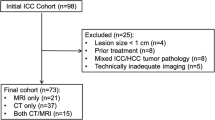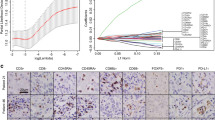Abstract
Objective
Clinical evidence suggests that the response to immune checkpoint blockade depends on the immune status in the tumor microenvironment. This study aims to predict the immunophenotyping (IP) and overall survival (OS) of intrahepatic cholangiocarcinoma (ICC) patients using preoperative magnetic resonance imaging (MRI) texture analysis.
Methods
A total of 78 ICC patients were included and divided into inflamed (n = 26) or non-inflamed (n = 52) immunophenotyping based on the density of CD8+ T cells. The enhanced T1-weighted MRI in the arterial phase was employed with texture analysis. The logistic regression analysis was applied to select the significant features related to IP. The OS-related feature was determined by Cox proportional-hazards model and Kaplan-Meier analysis. IP and OS predictive models were developed using the selected features, respectively.
Results
Three wavelets and one 3D feature have favorable ability to discriminate IP, a combination of which performed best with an AUC of 0.919. The inflamed immunophenotyping had a better prognosis than the non-inflamed one. The 5-year survival rates of the two groups were 48.5% and 25.3%, respectively (p < 0.05). The only wavelet-HLH_firstorder_Median feature was associated with OS and used to build the OS predictive model with a C-index of 0.70 (95% CI, 0.57, 0.82), which could well stratify ICC patients into high- and low-risk groups. The 1-, 3-, and 5-year survival probabilities of the stratified groups were 62.5%, 30.0%, and 24.2%, and 89.5%, 62.2%, and 42.1%, respectively (p < 0.05).
Conclusion
The MRI texture signature could serve as a potential predictive biomarker for the IP and OS of ICC patients.
Key Points
• The MRI texture signature, including three wavelets and one 3D feature, showed significant associations with immunophenotyping of ICC, and all have favorable ability to discriminate immunophenotyping; a combination of the above features performed best with an AUC of 0.919.
• The only wavelet-HLH_firstorder_Median feature was associated with the OS of ICC and used to build the OS predictive model, which could well stratify ICC patients into high- and low-risk groups.






Similar content being viewed by others
Abbreviations
- AUC:
-
Area under the curve
- GLCM:
-
Gray-level co-occurrence matrix
- GLDM:
-
Gray-level dependence matrix
- GLRLM:
-
Gray-level run length matrix
- GLSZM:
-
Gray-level size zone matrix
- ICB:
-
Immune checkpoint blockade
- ICC:
-
Intrahepatic cholangiocarcinoma
- IQR:
-
Interquartile range
- MRI:
-
Magnetic resonance imaging
- NGTDM:
-
Neighboring gray-tone difference matrix
- OS:
-
Overall survival
- PD-1:
-
Programmed cell death protein 1
- PD-L1:
-
Programmed cell death protein ligand 1
- ROC:
-
Receiver operating characteristic
- ROI:
-
Regions of interest
- TILs:
-
Tumor-infiltrating lymphocytes
References
Torre LA, Bray F, Siegel RL, Ferlay J, Lortet-Tieulent J, Jemal A (2015) Global cancer statistics, 2012. CA Cancer J Clin 65:87–108
Razumilava N, Gores GJ (2014) Cholangiocarcinoma. Lancet 383:2168–2179
Bridgewater J, Galle PR, Khan SA et al (2014) Guidelines for the diagnosis and management of intrahepatic cholangiocarcinoma. J Hepatol 60:1268–1289
Mavros MN, Economopoulos KP, Alexiou VG, Pawlik TM (2014) Treatment and prognosis for patients with intrahepatic cholangiocarcinoma: systematic review and meta-analysis. JAMA Surg 149:565–574
de Jong MC, Nathan H, Sotiropoulos GC et al (2011) Intrahepatic cholangiocarcinoma: an international multi-institutional analysis of prognostic factors and lymph node assessment. J Clin Oncol 29:3140–3145
Smyth MJ, Ngiow SF, Ribas A, Teng MW (2016) Combination cancer immunotherapies tailored to the tumour microenvironment. Nat Rev Clin Oncol 13:143–158
Schmid P, Adams S, Rugo HS et al (2018) Atezolizumab and Nab-Paclitaxel in advanced triple-negative breast cancer. N Engl J Med 379:2108–2121
Migden MR, Rischin D, Schmults CD et al (2018) PD-1 blockade with cemiplimab in advanced cutaneous squamous-cell carcinoma. N Engl J Med 379:341–351
Le DT, Uram JN, Wang H et al (2015) PD-1 Blockade in tumors with mismatch-repair deficiency. N Engl J Med 372:2509–2520
Kansy BA, Concha-Benavente F, Srivastava RM et al (2017) PD-1 Status in CD8(+) T cells associates with survival and anti-PD-1 therapeutic outcomes in head and neck cancer. Cancer Res 77:6353–6364
Chowell D, Morris LGT, Grigg CM et al (2018) Patient HLA class I genotype influences cancer response to checkpoint blockade immunotherapy. Science 359:582–587
Ansell SM, Lesokhin AM, Borrello I et al (2015) PD-1 blockade with nivolumab in relapsed or refractory Hodgkin’s lymphoma. N Engl J Med 372:311–319
Sabbatino F, Villani V, Yearley JH et al (2016) PD-L1 and HLA class I antigen expression and clinical course of the disease in intrahepatic cholangiocarcinoma. Clin Cancer Res 22:470–478
Chen DS, Mellman I (2017) Elements of cancer immunity and the cancer-immune set point. Nature 541:321–330
Topalian SL, Hodi FS, Brahmer JR et al (2012) Safety, activity, and immune correlates of anti-PD-1 antibody in cancer. N Engl J Med 366:2443–2454
Herbst RS, Soria JC, Kowanetz M et al (2014) Predictive correlates of response to the anti-PD-L1 antibody MPDL3280A in cancer patients. Nature 515:563–567
Hamid O, Robert C, Daud A et al (2013) Safety and tumor responses with lambrolizumab (anti-PD-1) in melanoma. N Engl J Med 369:134–144
Kim JM, Chen DS (2016) Immune escape to PD-L1/PD-1 blockade: seven steps to success (or failure). Ann Oncol 27:1492–1504
Hugo W, Zaretsky JM, Sun L et al (2016) Genomic and transcriptomic features of response to anti-PD-1 therapy in metastatic melanoma. Cell 165:35–44
Sharma P, Allison JP (2015) The future ofimmune checkpoint therapy. Science 348(6230):56–61
Garon EB, Rizvi NA, Hui R et al (2015) Pembrolizumab for the treatment of non-small-cell lung cancer. N Engl J Med 372:2018–2028
Tumeh PC, Harview CL, Yearley JH et al (2014) PD-1 blockade induces responses by inhibiting adaptive immune resistance. Nature 515:568–571
Shields AF, Jacobs PM, Sznol M et al (2018) Immune modulation therapy and imaging: workshop report. J Nucl Med 59:410–417
Ku YJ, Kim HH, Cha JH et al (2016) Correlation between MRI and the level of tumor-infiltrating lymphocytes in patients with triple-negative breast cancer. AJR Am J Roentgenol 207:1146–1151
Ku YJ, Kim HH, Cha JH et al (2018) Predicting the level of tumor-infiltrating lymphocytes in patients with triple-negative breast cancer: usefulness of breast MRI computer-aided detection and diagnosis. J Magn Reson Imaging 47:760–766
Lambin P, Leijenaar RTH, Deist TM et al (2017) Radiomics: the bridge between medical imaging and personalized medicine. Nat Rev Clin Oncol 14:749–762
Sun R, Limkin EJ, Vakalopoulou M et al (2018) A radiomics approach to assess tumour-infiltrating CD8 cells and response to anti-PD-1 or anti-PD-L1 immunotherapy: an imaging biomarker, retrospective multicohort study. Lancet Oncol 19:1180–1191
Hegde PS, Karanikas V, Evers S (2016) The where, the when, and the how of immune monitoring for cancer immunotherapies in the era of checkpoint inhibition. Clin Cancer Res 22:1865–1874
Zhang J, Huang Z, Cao L et al (2020) Differentiation combined hepatocellular and cholangiocarcinoma from intrahepatic cholangiocarcinoma based on radiomics machine learning. Ann Transl Med 8:119
Xu L, Yang P, Liang W et al (2019) A radiomics approach based on support vector machine using MR images for preoperative lymph node status evaluation in intrahepatic cholangiocarcinoma. Theranostics 9:5374–5385
Liang W, Yang P, Huang R et al (2019) A combined nomogram model to preoperatively predict histologic grade in pancreatic neuroendocrine tumors. Clin Cancer Res 25:584–594
Wu W, Parmar C, Grossmann P et al (2016) Exploratory study to identify radiomics classifiers for lung cancer histology. Front Oncol 6:71
Ahmed AA, Elmohr MM, Fuentes D et al (2020) Radiomic mapping model for prediction of Ki-67 expression in adrenocortical carcinoma. Clin Radiol 75:479 e417–479 e422
Tixier F, Le Rest CC, Hatt M et al (2011) Intratumor heterogeneity characterized by textural features on baseline 18F-FDG PET images predicts response to concomitant radiochemotherapy in esophageal cancer. J Nucl Med 52:369–378
Asahi Y, Hatanaka KC, Hatanaka Y et al (2020) Prognostic impact of CD8+ T cell distribution and its association with the HLA class I expression in intrahepatic cholangiocarcinoma. Surg Today. https://doi.org/10.1007/s00595-020-01967-y
Gu FM, Gao Q, Shi GM et al (2012) Intratumoral IL-17(+) cells and neutrophils show strong prognostic significance in intrahepatic cholangiocarcinoma. Ann Surg Oncol 19:2506–2514
Liang W, Xu L, Yang P et al (2018) Novel nomogram for preoperative prediction of early recurrence in intrahepatic cholangiocarcinoma. Front Oncol 8:360
Ji GW, Zhu FP, Zhang YD et al (2019) A radiomics approach to predict lymph node metastasis and clinical outcome of intrahepatic cholangiocarcinoma. Eur Radiol 29:3725–3735
Mosconi C, Cucchetti A, Bruno A et al (2020) Radiomics of cholangiocarcinoma on pretreatment CT can identify patients who would best respond to radioembolisation. Eur Radiol. https://doi.org/10.1007/s00330-020-06795-9
Funding
This project was supported by the National Natural Science Foundations of China (81771797, 81971571) and the 1.3.5 project for disciplines of excellence, West China Hospital, Sichuan University, China (ZYJC18008).
Author information
Authors and Affiliations
Corresponding authors
Ethics declarations
Guarantor
The scientific guarantor of this publication is Dr. Bin Song.
Conflict of interest
The authors of this manuscript declare no relationships with any companies, whose products or services may be related to the subject matter of the article.
Statistics and biometry
No complex statistical methods were necessary for this paper.
Informed consent
Written informed consent was waived by the Institutional Review Board.
Ethical approval
Institutional Review Board approval was obtained.
Methodology
• retrospective
• diagnostic or prognostic study
• performed at one institution
Additional information
Publisher’s note
Springer Nature remains neutral with regard to jurisdictional claims in published maps and institutional affiliations.
Supplementary Information
ESM 1
(DOCX 2615 kb)
Rights and permissions
About this article
Cite this article
Zhang, J., Wu, Z., Zhao, J. et al. Intrahepatic cholangiocarcinoma: MRI texture signature as predictive biomarkers of immunophenotyping and survival. Eur Radiol 31, 3661–3672 (2021). https://doi.org/10.1007/s00330-020-07524-y
Received:
Revised:
Accepted:
Published:
Issue Date:
DOI: https://doi.org/10.1007/s00330-020-07524-y




